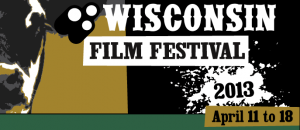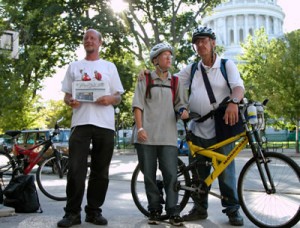“What is a Wisconsin Film?”: 2013 Wisconsin Film Festival
 What is a “Wisconsin” film? Such was the question facing me when I was offered a programming job in this year’s Wisconsin Film Festival. Now in its 15th year, the festival (running April 11th-18th) offers a wide range of cinematic offerings, from choice selections off the international film festival circuit to retrospectives full of little-seen gems from decades past. For lovers of locally-grown film, however, this yearly cinematic smorgasbord is perhaps most notable for its “Wisconsin’s Own” slate, showcasing an array of movies with state and regional connections. It was this section that I was charged with helping to program, and it was within this capacity that the aforementioned question first began to percolate in my brain.
What is a “Wisconsin” film? Such was the question facing me when I was offered a programming job in this year’s Wisconsin Film Festival. Now in its 15th year, the festival (running April 11th-18th) offers a wide range of cinematic offerings, from choice selections off the international film festival circuit to retrospectives full of little-seen gems from decades past. For lovers of locally-grown film, however, this yearly cinematic smorgasbord is perhaps most notable for its “Wisconsin’s Own” slate, showcasing an array of movies with state and regional connections. It was this section that I was charged with helping to program, and it was within this capacity that the aforementioned question first began to percolate in my brain.
The problems and possibilities of defining cinema geographically have long bedeviled scholars of national cinemas, and have become all the more complicated as the contemporary cinematic universe has become increasingly diasporic in nature. As it turns out, many of the questions germane to conceptualizing modern-day film’s regional character (or lack thereof) can be found in microcosmic form in this year’s festival line-up. For every film that comfortably fits into a traditional idea of a cinema defined by local landmarks and culture, there is another that escapes easy classification, pushing us to consider what it is we mean when we claim a film as “Wisconsin’s Own.”
Take perhaps the most basic of regional-cinema boundaries: geography. Certainly, several of this year’s offerings use local spaces and institutions to vivid effect. In Flog Therapy and University of Wisconsin-Madison: Zoological Research Collections, filmmakers (and UW-Madison students) Ayla Larson and Billy Johnson sketch the interiors of the Inferno Nightclub and the university’s zoological research labs, respectively, in playful and unexpected fashion. Towns like Lodi, Sauk Prairie, and Baraboo form the bucolic backdrop against which director Jonathon Quam tells a quietly devastating story of childhood abuse and fraternal bonds in Blood Brothers.
But what to do with a film like Delphine Lanson’s Father’s Birth, a heartfelt love letter to the complexity of modern families that splits its time evenly between Waukesha and Paris? Or The Librarian and the Banjo, in which director Jim Carrier hopscotches from Madison to New Jersey to Tennessee as he tells the story of Dena Epstein, a music librarian who wrote the definitive book placing the origins of the titular instrument in African and African American culture? Their ties to Wisconsin are essential, but their stories cannot be told without leaving the confines of the state.
And what of those films whose “locales” barely reside in the physical world at all? Using stop-motion techniques to animate Lego characters, Eric J. Nelson’s Siszilla pays gloriously low-fi homage to both the Toho classic and the glories of childhood play. On the other end of the tonal spectrum, Meghan Allynn Johnson’s The Howdy House presents a meeting at a restaurant (in St. Louis, natch) through stop-motion as well, though the results swerve between the beguilingly surreal and inexplicably unsettling.
 What of works that explicitly enmesh themselves with the issues, mores, and culture of the state? Marc Kornblatt’s Street Pulse (pictured) refracts the experience of Madison’s homeless population through the stories of several individuals, most memorably a married couple whose large difference in age and experience do not deter them from forging a life together, on and off the street. The capitol’s annual summer solstice festival gets captured via a playful pastiche style in Meghan Monday and Brijetta Hall Waller’s Solstice. Such films take a powerful look at the state of Wisconsin today, offering insights and observations that only a ground-level view can provide. Yet might a “Wisconsin” film capture more intangible feelings, moods, thoughts—ones experienced in a given place and time but not bound to it exclusively? An audience in a university town like Madison will laugh knowingly (and perhaps sigh wistfully) at the gentle skewering of fratty men aging semi-gracefully in Mark Kerins’ Drunken Phone Calls, but so will anyone who knows the gentle ache of growing up and apart from one’s college pals. The haze of familial memory and emotion explored so sensitively by Kellie Bronikowski in Somewhere in Between has a reach that knows no geographic boundaries.
What of works that explicitly enmesh themselves with the issues, mores, and culture of the state? Marc Kornblatt’s Street Pulse (pictured) refracts the experience of Madison’s homeless population through the stories of several individuals, most memorably a married couple whose large difference in age and experience do not deter them from forging a life together, on and off the street. The capitol’s annual summer solstice festival gets captured via a playful pastiche style in Meghan Monday and Brijetta Hall Waller’s Solstice. Such films take a powerful look at the state of Wisconsin today, offering insights and observations that only a ground-level view can provide. Yet might a “Wisconsin” film capture more intangible feelings, moods, thoughts—ones experienced in a given place and time but not bound to it exclusively? An audience in a university town like Madison will laugh knowingly (and perhaps sigh wistfully) at the gentle skewering of fratty men aging semi-gracefully in Mark Kerins’ Drunken Phone Calls, but so will anyone who knows the gentle ache of growing up and apart from one’s college pals. The haze of familial memory and emotion explored so sensitively by Kellie Bronikowski in Somewhere in Between has a reach that knows no geographic boundaries.
And let’s not even get started on the matter of defining a “Wisconsin film” by directorial biography. Nathan Punwar—the director of the dizzying, dazzling Loves of a Cyclops—spent almost his entire youth in Madison, but lives and works in Brooklyn, NY. Joel Allen Schroeder grew up in Madison and attended UW-Madison for two years…before transferring to USC and residing in Los Angeles—his heartfelt documentary, Dear Mr. Watterson, explores the lasting legacy of the Calvin and Hobbes comic-strip. Are they any less “Wisconsin filmmakers” than, say, Steve Miosku, a UW-Milwuakee student whose Gears—a masterfully ambiguous tale of a father, daughter, and the mysterious forces threatening to separate them—was made entirely in the state with an all-Wisconsin crew? (Never mind that he grew up in New York City.)
The examples could go on and on, but the message is clear: in an age of ever-increasing mobility and cross-continental communication, filmmakers and films are rarely products of a single environment. Far from suggesting a dilution of regional identity in the face of hyper-connected postmodern culture, though, such imbrication of influence showcased in this year’s “Wisconsin’s Own” selections speaks to the exciting way in which films tied to a particular place nevertheless negotiate multiple influences in surprising and original ways. They suggest that Wisconsin identity itself is not a static bundle of characteristics, but a dynamic way-station where ideas and identities from various times and places overlap, intersect, and fuse together. It should come as no surprise, then, that such a locale would produce such a vivid, unpredictable, and invigorating selection of films.
Madisonians and others will be able to see these films for themselves starting tomorrow and continuing on through April 18th. Whether lifelong Wisconsinites, globe-hopping transplants, or somewhere in between, we can with pleasure claim these films as “our own”—an identification as multifaceted in theory as it is invigorating in practice.


